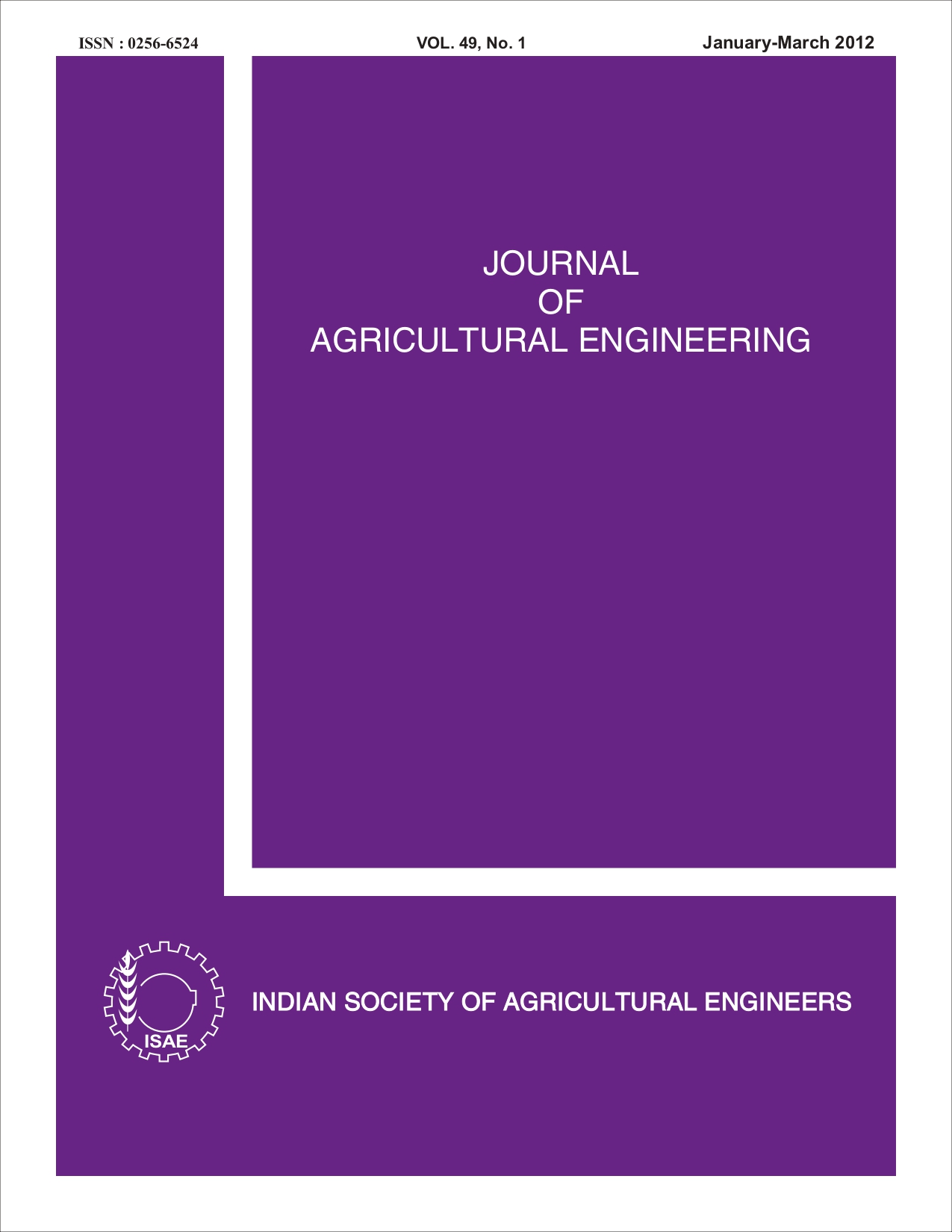Detection of Fungal Infection in Canola using Near-Infrared Hyperspectral Imaging
DOI:
https://doi.org/10.52151/jae2012491.1464Keywords:
Hyperspectral imaging , NIR , Fungal infection, CanolaAbstract
Near-infrared (NIR) hyperspectral imaging was used to detect the presence of fungal infection in stored canola. Artificially fungal infected (Aspergillus glaucus group) canola was subjected to single kernel imaging every two weeks after incubation using an NIR imaging system in the wavelength range of 1000 to 1600 nm at 60 evenly distributed wavelengths. Three wavelengths 1100, 1230 and 1300 nm were identified as significant wavelengths and used in the analysis. Statistical discriminant classifiers (Linear and Quadratic) were used to classify healthy, two–, four–, six–, eight–, and ten–week fungal incubated samples. The linear and quadratic statistical classifiers gave maximum accuracy of 99% for healthy samples and 100% for fungal infected samples at later stages of infection levels and 90 to 95% for the first four weeks of A. glaucus infected samples.References
Anon. 2011. Generals and oilseeds review. Statistics Canada Catologue No. 22-007.
Brogan I W. 1986. Control of rapeseed quality for crushing. In: Scarisbrick D H; Daniels R W. (Eds.), Oilseed Rape, Collins, London, UK, pp. 282- 300.
Canola Council of Canada. 2008. Socio-Economic Value Report. Available online: http://www.canolacouncil.org/uploads/Canola_in_Canada_Socio_Economic_Value_Report_January_08.pdf.
Delwiche S R; Massie D R. 1996. Classifcation of wheat by visible and near-infrared reûectance from single kernels. Cereal Chem., 73, 399–405.
Geladi P; Grahn H. 1996. Multivariate Image Analysis. John Wiley and Sons, Chichester, UK.
Goetz A F H; Vane G; Solomon T E; Rock B N. 1985. Imaging spectrometry for earth remote sensing. Science, 228, 1147-1153.
Gowen A A; O’Donnell C P; Cullen P J; Bell S E J. 2008. Recent applications of chemical imaging to pharmaceutical process monitoring and quality healthy. Eur. J. Pharm. Biopharm., 69, 10-12.
Magan N. 1993. Early detection of fungi in stored grain. Int. Biodeterior. Biodegrad., 32, 145-160.
Mahesh S; Manickavasagam A; Jayas D S; Paliwal J; White N D G. 2008. Feasibility of near-infrared hyperspectral imaging to differentiate Canadian wheat classes. Biosystems Engng., 101, 50-57.
Mills J T; Sinha R N; Wallace H A H. 1978. Assessment of quality criteria of stored rapeseed- A multivariate study. J. Stored Prod. Res., 14, 121-133.
Monteiro S; Minekawa Y; Kosugi Y; Akazawa T; Oda K. 2007. Prediction of sweetness and amino acid content in soybean crops from hyperspectral imagery. ISPRS J. Photogramm., 62(1), 2-12.
Murray I; Williams P C. 1987. Chemical principles of near-infrared technology. In: Williams P C; Norris K H. (Eds.), Near-infrared Technology in the Agricultural and Food Industries, American Association of Cereal Chemists Inc, St. Paul, MN, 17–34.
Naganathana G K; Grimesb L M; Subbiaha J; Calkinsb C R; Samalc A; Meyera G E. 2008. Visible/near-infrared hyperspectral imaging for beef tenderness prediction. Comp. Electron. Agric., 64(2), 225-233.
Narvankar D S; Singh C B; Jayas D S; White N D G. 2009. Assessment of soft X-ray imaging for detection of fungal infection in wheat. Biosystems Engng., 103, 49-56. Paulsen M R. 1990. Using machine vision to inspect oilseeds. Inform. American Oil Chemists’ Society, 1(1), 50-55.
Pronyk C; Muir W E; White N D G; Abramson D. 2004. Carbon dioxide production and deterioration in stored canola. Can. Biosyst. Engmg., 46, 3.25-3.33.
Singh C B; Jayas D S; Paliwal J; White N D G. 2007. Fungal detection in wheat using near-infrared hyperspectral imaging. Trans. ASABE, 50(6), 2171-2176.
Singh C B; Jayas D S; Paliwal J; White N D G. 2010a. Detection of midge-damaged wheat kernels using shortwave near-infrared hyperspectral and digital colour imaging. Biosystems Engmg., 105, 380-387.
Singh C B; Jayas D S; Paliwal J; White N D G. 2010b. Identification of insect-damaged wheat kernels using softwave near-infrared hyperspectral and digital colour imaging. Comp. Electron. Agric., 73, 118-125.
Sinha R N; Wallace H A H. 1977. Storage stability of farm-stored rapeseed and barley. Can. J. Plant. Sci., 57, 351-365.
Walcott R R; McGee D C; Misra M K. 1998. Detection of asymptomatic fungal infections of soybean seeds by ultrasound analysis. Plant Dis., 82(5), 584-589.
Wang D; Dowell F E; Lacey R E. 1999. Single wheat kernel color classifcation using neural networks. Trans. ASAE, 42, 233–240.
Wang D; Dowell F E; Ram M S; Schapaugh W T. 2003. Classification of fungal damaged soybean seeds using near infrared spectroscopy. Int. J. Food Prop., 7, 75-82.
Williams A P. 1989. Methodology developments in food mycology. J. Appl. Bacteriol., 67(S), 612-617.














